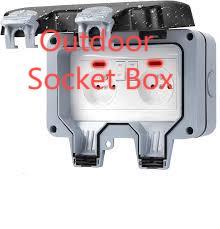When planning exterior electrical installations, specifying the correct Electrical Outdoor Box in the design phase prevents many common failures, because a purpose-built enclosure resists weather, pests, and mechanical wear; thoughtful selection and placement of the Electrical Outdoor Box can dramatically reduce maintenance costs and improve safety for both users and technicians. This article examines material choices, protection ratings, installation details, practical features, and long-term planning strategies to help engineers, contractors, and property owners choose enclosures that perform reliably in real-world outdoor conditions.
Materials That Withstand Time and Climate
Material selection determines how an enclosure ages. UV-stable thermoplastics resist fading and brittleness under prolonged sun exposure, while powder-coated aluminum and stainless steel offer mechanical strength and excellent corrosion resistance in harsher environments. Pay close attention to hardware—screws, hinges, and mounting brackets—because inferior fasteners are often the first point of failure. Gasket materials also matter: silicone and EPDM gaskets maintain compressibility and sealing performance across wide temperature ranges, protecting sensitive equipment inside.
Ratings, Seals, and Thermal Considerations
Ingress Protection (IP) and impact resistance (IK) ratings give objective measures of performance. Choose an IP rating appropriate for expected exposure—IP65 or higher for general outdoor use, and even higher where direct water jets or submersion might occur. For cabinets that house heat-generating devices, plan thermal management through passive vents, heat-dissipating mounting plates, or internal spacers to prevent hotspots. Any ventilation strategy must maintain the integrity of the sealing plane and the enclosure’s protective rating.
Practical Installation Features That Save Time (Nante Design)
Smart design details ease installation and future maintenance. Removable mounting plates, captive screws that never fall into cavities, pre-marked knockouts, and integrated gland plates speed up wiring and reduce on-site modifications. Clear internal labeling and modular DIN-rail options simplify component layout and future upgrades. These practical features not only lower labor hours but also preserve sealing integrity—minimizing the risk of water ingress caused by field alterations.
Best Practices for Siting and Mounting
Correct placement and mounting orientation mitigate many environmental hazards. Install enclosures on stable, vibration-free surfaces and position cable entries to avoid direct runoff paths. Use properly sized cable glands and strain reliefs to prevent conductor fatigue, and maintain a sealing plane by avoiding over-tightened screws that distort gaskets. In areas prone to condensation, consider breathable membranes or small engineered vents that allow moisture to escape without admitting contaminants.
Planning for Future Functionality and Smart Systems
Modern outdoor projects increasingly require space for surge protection, communication modules, and environmental sensors. When specifying enclosures, anticipate future add-ons by choosing deeper boxes or models with configurable interiors. Modular solutions let installers add DIN-rail-mounted devices or communication gateways without replacing the entire cabinet. This forward-looking approach reduces lifecycle costs and keeps infrastructure adaptable as technology evolves.
Selecting an enclosure is a systems decision that balances environment, component heat load, mounting realities, and future requirements. Prioritize proven materials, correct IP/IK ratings, and practical internal layouts to ensure long-term equipment protection and ease of service. For detailed product specifications, certified test results, and configurable solutions suited to diverse outdoor applications, visit www.nante.com/product/
